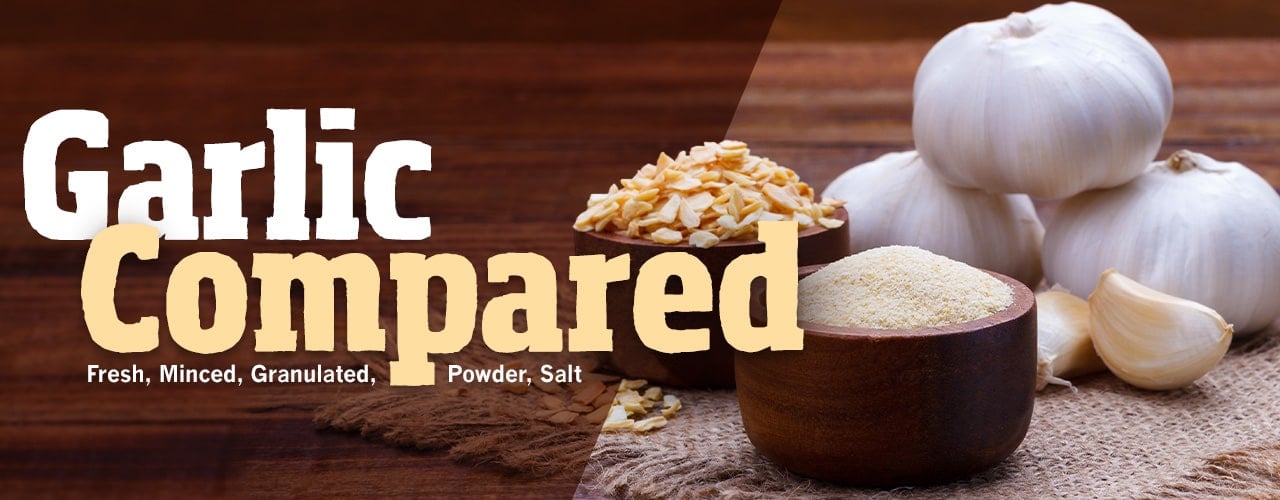Garlic Compared: Cooking With Garlic Products
Last updated on May 17, 2021Janine JonesIf you’re starting a restaurant or are a professional chef, you know that garlic is an essential ingredient in many recipes. But when it comes to choosing the best garlic form for your signature dishes, which do you reach for: fresh garlic, minced garlic, granulated garlic, garlic powder, or garlic salt? We explore these different garlic products to help you choose the best variations for your kitchen pantry.
Shop All Garlic ProductsWhat Is a Garlic Clove?
A garlic clove is one of the many segments that make up a garlic bulb. It can be separated from the bulb or head, peeled, and added to a variety of savory dishes. Garlic is an herb in the Allium family, which is the same family as onions and shallots. There are several species of garlic, each with their own unique pungent flavors. Garlic cloves should be stored out of the bag and in a cool, dry place to keep it from sprouting. Sprouted garlic is still safe to eat but will have more of a bitter taste than its fresh unsprouted counterpart.
How Many Cloves Are In a Head of Garlic?
There can be anywhere from 8 to 20 cloves in a head of garlic depending on the species. Softneck varieties, which do not have a clear center stalk, are the most common type of garlic in local grocery stores and will typically have 10-20 cloves. Hardneck varieties, which have a thick woody stalk, are considered more of a delicacy and only have 8-12 cloves in a head.
Cooking with Fresh Garlic
Fresh garlic is full of health benefits and can be added to savory recipes for a delicious burst of flavor. Garlic cloves can be used whole for subtle notes or cut to release the sulfur compounds in the garlic, which activates a bold and vibrant flavor. The following are just some ways to use fresh garlic:
- Roast the garlic head in foil to make the cloves sweet, soft, and spreadable to smear on bread or mash into a sauce.
- Roast individual cloves to soften and blend into mashed potatoes for a more complex flavor profile.
- Cut the garlic clove into slices to roast on a sheet pan with green beans and Brussels sprouts, bake with hasselback potatoes, or saute in a skillet with chicken breast.
- Pound into a paste to make aioli for sandwiches and seafood.
- Chop up fine to make homemade minced garlic.
- Use a garlic press to crush fresh garlic into sauces and dips.
What Is Minced Garlic?

Minced garlic is a clove of garlic that has been finely chopped before being added to a dish. You can make it from fresh garlic or purchase it at your local grocery store. When store bought, it is usually preserved in water or oil, or it can be sold as a dried herb. If the garlic is freshly minced, it will have a sweeter and more potent flavor and aroma than if it is preserved or dried. Store-bought versions may feature other ingredients like oil, water, or salt to keep the garlic fresh which may alter the flavor.
Minced Garlic Uses
Minced garlic is excellent for evenly distributing subtle garlic flavor into your dish. Because the garlic pieces are small, they will soften more quickly than a garlic clove and dissolve into other ingredients of your recipe.
Jarred minced garlic remains soft in the oil or water, which can help you add texture and moisture to your dishes while saving you time by eliminating the need to chop your own garlic. Dried minced garlic is also a timesaver, but is better suited for dishes that benefit from the lack of added moisture, like a vegetable seasoning or meat dry rub. Here are some ways you can enjoy cooking with minced garlic:
- Add jarred minced garlic to your shrimp scampi recipe to create an eye-catching dish with visible garlic chunks.
- Saute jarred minced garlic in a cast iron skillet before searing some sausage or steak.
- Liven up a tapenade with a spoonful of minced garlic to starkly contrast the olives.
- Use dry minced garlic to create a memorable dry rub for your smoked meats.
- Sprinkle dried minced garlic on bread rolls for an added crunch.
Fresh Garlic vs Minced Garlic
The difference between fresh garlic and minced garlic is that fresh garlic is a whole clove, while minced garlic is a chopped clove that can be used fresh, dried, or preserved. Minced garlic is going to have a stronger flavor than an intact garlic clove because garlic releases sulfur compounds when cut. The finer the mince size, the stronger the aroma and taste. Opt for fresh whole garlic when you want the garlic flavor to be mild. If you want a more potent garlic taste, go with the minced garlic. Use 1/2 tsp. of jarred minced garlic when substituting it for a fresh garlic clove.
Back to TopWhat Is Granulated Garlic?

Granulated garlic is dried garlic that has been coarsely ground to a sand-like consistency. It's made by drying fresh garlic cloves in an oven, then grinding the cloves into garlic granules with a spice grinder. You can usually find granulated garlic bottled in the seasoning aisle of your local grocery store.
Granulated Garlic Uses
Granulated garlic is often used as a seasoning for sauces and dry rubs because of how well it distributes the garlic flavor in a dish without adding moisture. Try some of these methods when cooking with granulated garlic:
- Sprinkle granulated garlic over a slice of hot pizza to complement the umami flavors in the cheese.
- Stir granulated powder into a chowder to allow the garlic flavor to shine through.
- Prepare a rack of ribs for the smoker by adding granulated garlic to your dry rub.
- Coat your breadsticks with granulated garlic before baking for a unique texture and slight crunch.
Granulated Garlic vs Fresh Garlic
Granulated garlic is the dried ground form of fresh garlic. It is a convenient option to have in a kitchen because fresh garlic can sprout and go bitter while the granulated garlic flavor remains constant during the span of its shelf life. While fresh garlic only lasts 4-6 months, granulated garlic can last 2-3 years when stored properly. Fresh garlic has a more subtle and sweet flavor compared to granulated garlic, which has a more potent and concentrated taste. Use 1/4 tsp. of granulated garlic when substituting it for a fresh garlic clove.
Granulated Garlic vs Minced Garlic
Granulated garlic is the dried form of minced garlic but is ground slightly finer than dried minced garlic. While both variations are a time saver in the kitchen, there are some instances where granulated garlic might be the better option for your recipe.
You would choose jarred minced garlic over granulated garlic if you have a recipe that benefits from the moisture and texture of minced garlic, like an olive oil bread dip. Granulated garlic would be better suited for soups and sauces than minced garlic because it will dissolve more quickly into your liquid base.
Dried minced garlic and granulated garlic only vary in their granule size but can be used in different ways. Use dried minced garlic in coarse herbal blends that show off the larger granules, but use granulated garlic in finely blended spice blends.
What Is Garlic Powder?

Garlic powder is made of dehydrated garlic cloves that have been dried and finely ground to a flour-like consistency. The fine consistency allows the garlic to disintegrate quickly and incorporate into a recipe. Because of the small granule size, garlic powder tends to have the most concentrated and pungent garlic flavors from the other garlic product varieties.
Garlic Powder Uses
Garlic powder is excellent for incorporating garlic flavor without impacting the texture of your recipe. Use some of these techniques when cooking with garlic powder:
- Sprinkle garlic powder on buttered bread to make a delicious garlic bread.
- Season soups to perfection by stirring in some garlic powder.
- Add garlic powder to boiling water to help season pasta as it cooks.
- Liven up your signature salad dressing with garlic powder in the recipe.
- Sprinkle garlic powder on taco meat for a burst of flavor without impacting the meat’s moisture levels.
Granulated Garlic vs Garlic Powder
The only difference between garlic powder and granulated garlic is the granule size. While granulated garlic is coarsely ground to a sand consistency, garlic powder is finely ground to a flour consistency. Due to the size difference, garlic powder is more potent in flavor than granulated garlic because more of the surface area of the garlic is exposed to oxygen, releasing more of the sulfur compound. While you would need 1/4 tsp. of granulated garlic to substitute a clove of garlic, you would only need 1/8 tsp. of garlic powder to achieve the same flavor effect.
Choose granulated garlic over garlic powder if you want your recipe to feature a crunch with the garlic flavor, like on a rotisserie chicken. Granulated garlic is also less likely to clump in the bottle than garlic powder. You would want garlic powder over granulated garlic when you need your garlic product to dissipate and meld into the consistency of your recipe quickly without adding texture, like in a pasta sauce. Be sure to sift the ingredient into your dish to avoid clumps.
Garlic Powder vs Garlic
The difference between garlic powder and fresh garlic is that garlic powder is the dried and finely ground form of garlic. It’s more convenient to have on hand because you can store garlic powder in your pantry for 2-3 years, while fresh garlic can sprout and go bitter in a few months. While fresh garlic has a sweeter and more subtle flavor than garlic powder, a little garlic powder can go a long way. You only need 1/8 tsp. of garlic powder to imitate the taste of fresh garlic in a recipe.
Because of fresh garlic's subtle flavor and soft texture, it is the preferred option for recipes like pizza sauce, pasta sauces, and stir fries where you want other flavors to shine through. For recipes that rely heavily on garlic flavoring, like marinades, salad dressings, and cream-based soups, garlic powder is an excellent option in place of fresh garlic.
Garlic Powder vs Minced Garlic
Garlic powder and minced garlic are both convenient options to keep in your pantry in place of fresh garlic because of their long shelf life. Minced garlic can be wet or dried and is coarsely cut, while garlic powder is dried and ultra-fine. You would use minced garlic when you want chunks of garlic and a more mild flavor. Choose garlic powder when you want a strong garlic flavor but do not want the garlic granules to be detectable.
Back to TopWhat Is Garlic Salt?

Garlic salt is just garlic powder with salt added to the mixture. It can be made with garlic powder or granulated garlic. Garlic salt is usually 1 part garlic powder to 3 parts salt with an anti-caking agent added.
Garlic Salt Uses
Garlic salt is a great timesaver in the kitchen because it is two seasoning ingredients in one bottle. Here are some ways you can incorporate garlic salt in your cooking:
- Season ground beef for hamburgers, tacos, and chili with garlic salt to keep from having to grab two ingredients from your pantry.
- Give your french fries a unique twist by using garlic salt instead of plain salt.
- Add delicious flavor to roasted asparagus by sprinkling garlic salt on them before roasting.
Garlic Powder vs Garlic Salt
The difference between garlic salt and garlic powder is that garlic salt is garlic powder just with salt added. The ratio of salt to garlic powder is 3:1. You can use garlic salt in any recipe that calls for both salt and garlic. Add garlic salt slowly to your recipes to ensure you are not over-salting when using this time-saving duo.
Granulated Garlic vs Garlic Salt
You can use granulated garlic to make garlic salt but would need a 3:2 salt-to-granulated garlic ratio to achieve a balanced flavor. Remember that there will be more texture associated with garlic salt made with granulated garlic instead of garlic powder, so add the seasoning slowly so you can make changes to your recipe as needed.
Garlic Conversions
You may not always have fresh garlic in your kitchen but you likely have a dried variation in your herbs and spices pantry due to their long lifespan. Use the following conversions to replace a medium clove of fresh garlic with a garlic alternative that may already have on hand:
- Minced Garlic to Clove: 1/2 tsp. = 1 clove
- Granulated Garlic to Clove: 1/4 tsp. = 1 clove
- Garlic Powder to Clove: 1/8 tsp. = 1 clove
- Garlic Salt to Clove: 1/2 tsp. = 1 clove + 3/8 tsp. salt
Out of all garlic options or have a garlic allergy? Try using chopped shallots or onion to add a burst of flavor in its place.
Back to TopCreate delicious dishes and a versatile menu with a wide selection of garlic products in your pantry. Whether you’re making rich sauces or smoked meats, garlic is the perfect ingredient to add depth of flavor to your recipe. Use this resource to help you choose the right garlic product and make the appropriate conversions to prepare dishes that your customers and guests will love.








